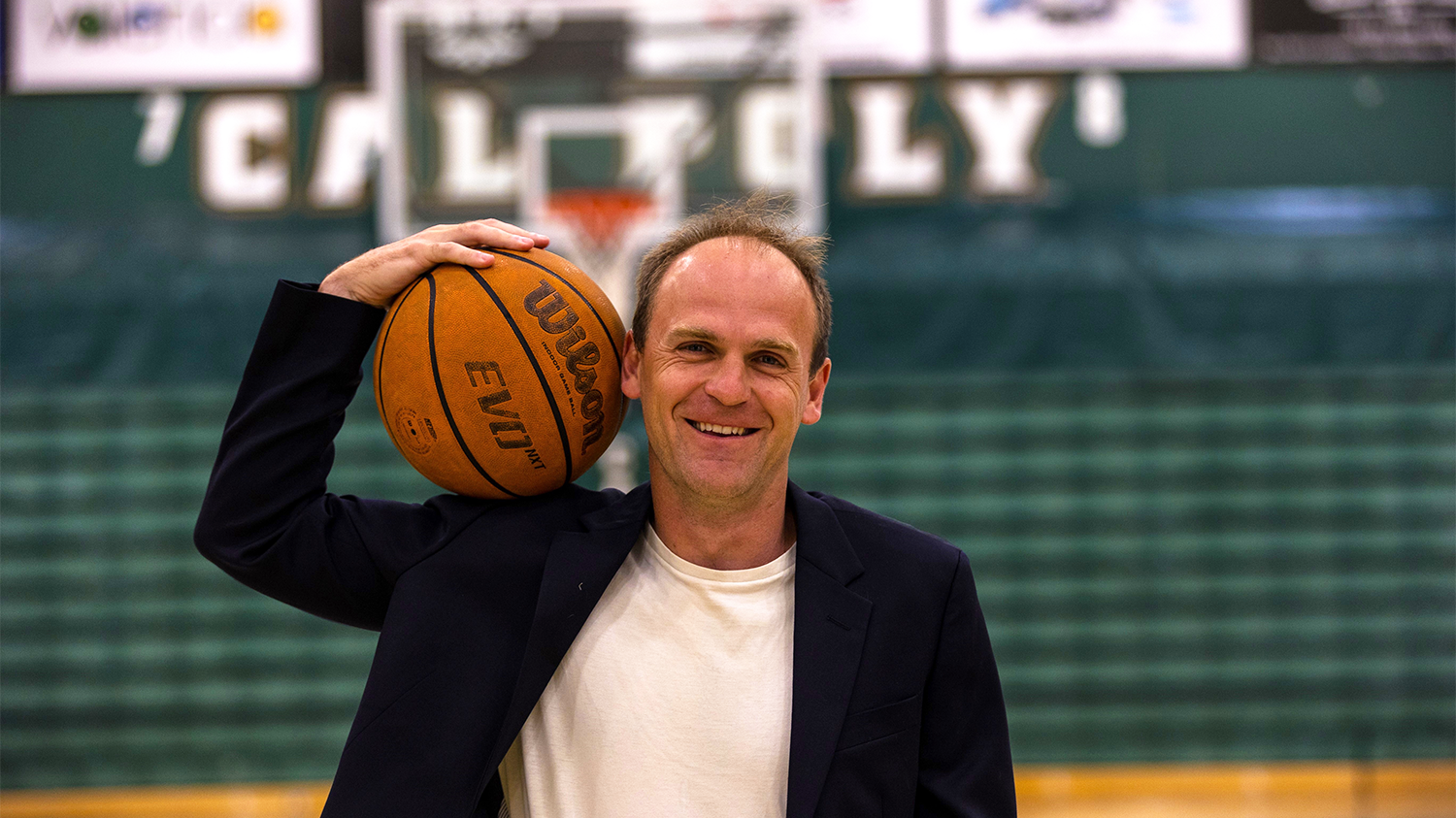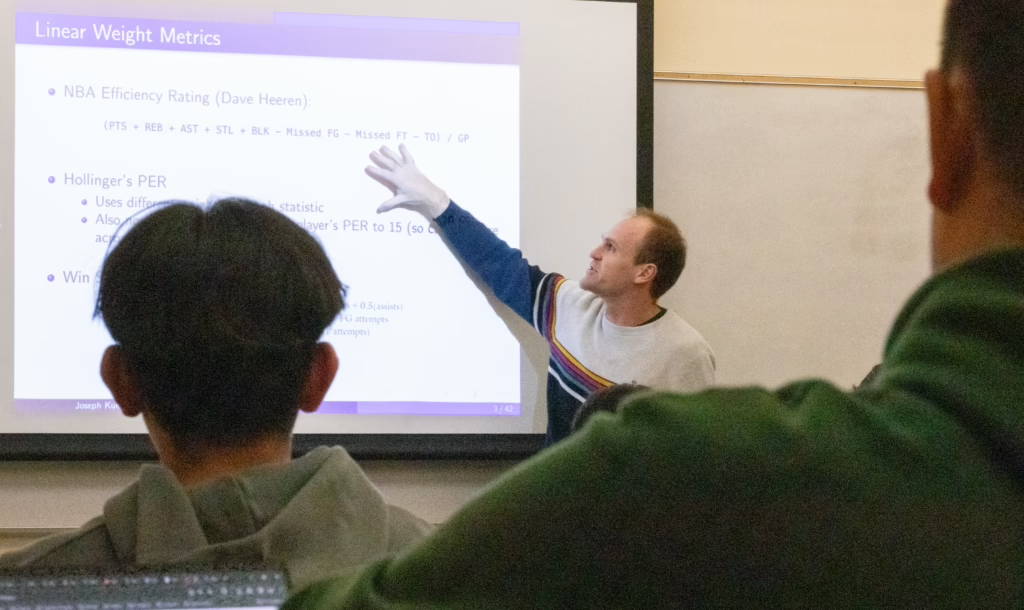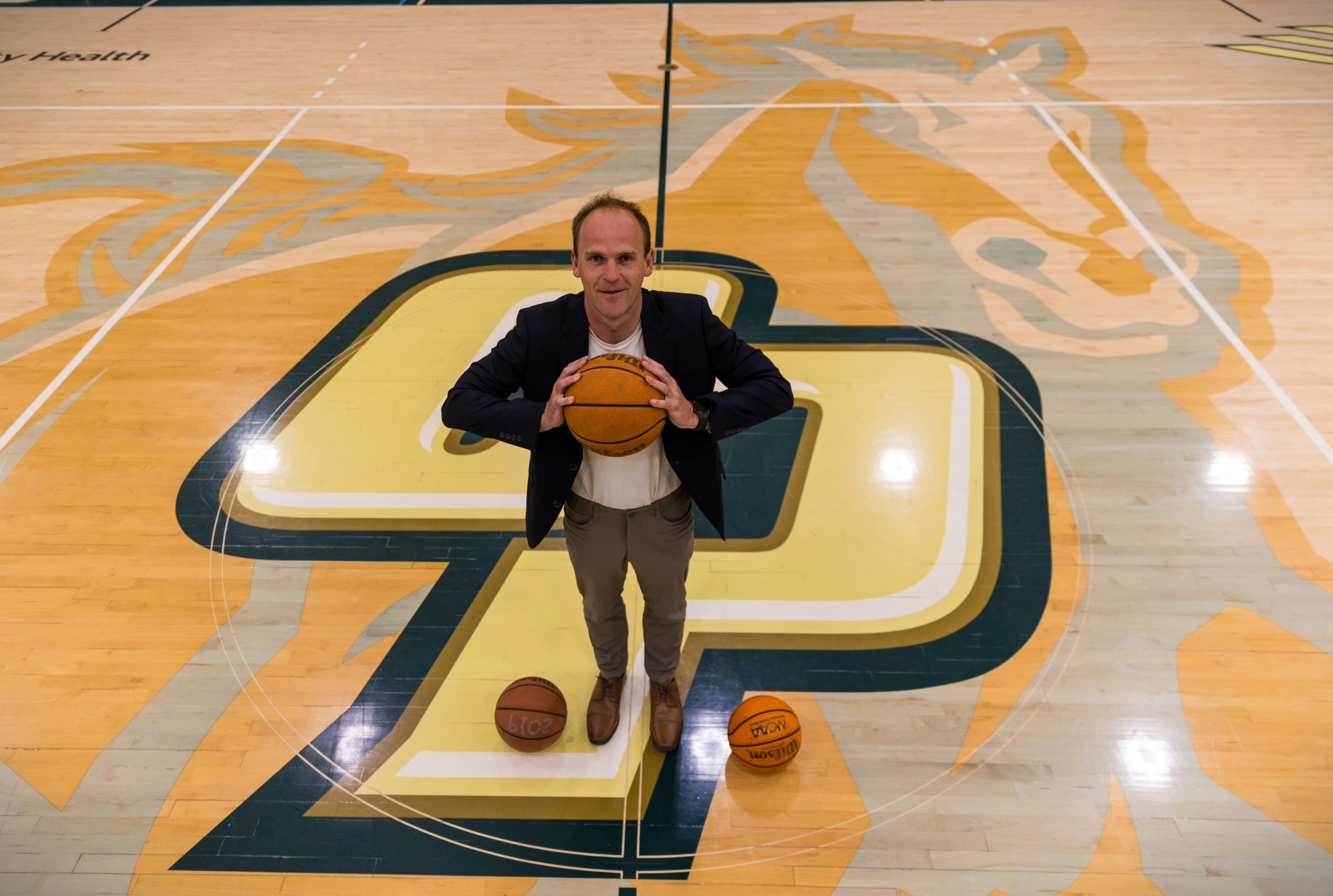Economics Professor Who Researched How to Build Winning Teams Discusses This Year’s NBA Finals

Joseph Kuehn, an associate professor of economics, has researched how NBA teams can best build winners by assembling rosters with players that compliment each other. (Photo: Pat Pemberton0
Indiana Pacers power forward Pascal Siakam and point guard Tyrese Haliburton are the best teammates in this year’s NBA Finals, according to an economics professor who has researched how teams can build winners.
“My research says that the best complementarities are generated between Haliburton and Siakam,” said Joseph Kuehn, associate professor in the Orfalea College of Business. “Siakam does not need the ball and is an efficient scorer from various positions on the court. This perfectly complements Haliburton’s strengths as a passer and a ball dominant player.”
At the same time, Kuehn noted, Oklahoma City has plenty of talent and stifling defense.
“I know everyone is saying how unhappy the NBA must be that they have two small market teams in the finals, but this is a really exciting matchup,” he said. “The fast-paced offense of Indiana has been a thrill to watch in the playoffs, and OKC’s defense has been suffocating. I think it will be a great matchup of strength versus strength. “
Kuehn’s research, which has been cited by ESPN, the Athletic and others, concluded that NBA executives have wasted money focusing on individual offensive production instead of compiling rosters that work well together. The two teams in this year’s finals – both small market teams with low payrolls – suggests a shift in how winners are built, Kuehn said.
We asked him to size up this year’s finals, which begins Thursday, based on his research.
The Pacers have a well-balanced team – lots of guys who contribute and no LeBron James megastars. How do their skills complement each other?
Pascal Siakam was a great addition to the Pacers last year as a guy that really complements what their star Haliburton does. Siakam doesn’t need the ball and is a fairly efficient shooter (51.9% from field and 38.9% from three). Haliburton’s strength is in transition, and Siakam does a good job running the floor with him and finishing. In Siakam, Haliburton finally has someone to take advantage of his great court vision and passing.

Joseph Kuehn speaks to students about NBA analytics. (Photo: Jahan Ramezani)
Myles Turner is also a strong complementary piece. He shoots well from three for a big, and this stretches the defense out and allows for opportunities down low, which Siakam is great at taking advantage of. My research shows that playing with Turner significantly increases the down-low opportunities that Siakam gets, which he is very efficient at finishing.
I will say that one area where the team does not complement each other is in rebounding. Neither Turner nor Siakam are great rebounders. According to my ratings, both players were below average rebounders this year.
The top three players on OKC don’t complement each other in the traditional way that my research looks at. Both SGA (Shai Gilgeous-Alexander) and Jalen Williams are best with the ball in their hands, and so playing with SGA does reduce Williams’ productivity. As far as Chet Holmgren and SGA, Chet’s propensity to shoot outside does help space the floor for SGA, who is best at driving toward the rim, but they don’t complement each other the way other guard-bigs in the league do, such as Jamal Murray and Nicola Jokic.
Oklahoma City was 25th (out of 30) in player payroll, according to Basketball Reference, and they didn’t have a single player in the top 30 highest salaries, according to ESPN. Yet they had the NBA’s best record. How did they do it?
They drafted really well and made some great trades for young talent. Acquiring SGA from the Clippers after his first year in the league was a franchise-altering move. And then they have been able to draft well to surround him with more talent. While Chet was a consensus top pick, the pick of Jalen Williams at 12 in 2022 was a steal. They’ve also been able to find strong role players in the draft, such as Cason Wallace, to help fill out the roster.
The ultimate answer is that they are young, and so most of their contributing players are still on their initial deals. Chet, Williams, and Wallace are all still on their rookie contracts. And while SGA did sign a max extension, I believe he still isn’t one of the 30 highest paid players in the league. So having young talent, which you get by drafting well, is a key way to win without having a large payroll.
The 2020-22 Brooklyn Nets team that was loaded with superstars Kevin Durant, Kyrie Irving and James Harden was a major disappointment , never even making the conference finals. What message should this send to the NBA general managers about building winners?
This is a great example of star players who don’t complement each other well. All three of those players are ball dominant and so playing them together decreases their productivity. By playing them together, you only get about a third of each’s individual production.
They only played 16 games together and so that might have been another problem. They were never healthy. But I think even if they were healthy, that team wouldn’t have worked. They needed some size for rebounding and defense, and they traded that all away to get Harden.
Indiana and OKC are two smaller market teams, with lower payrolls, from the Midwest. What does that suggest for how the game has changed?
What I think it means for the game is that the league is less star driven than it was in the past. In the 1990s Michael Jordan was the best player, and the Bulls won six championships (and would likely have won more if he didn’t go play baseball in the middle). Then in the 2000s the stars of the league were Kobe (Bryant) and Tim Duncan, and the Lakers won five titles, and the Spurs won four during that stretch. And then we had the LeBron years where he went to the NBA finals for eight straight years from 2011-2018. But now the league is in a place where there aren’t one or two stars that dominate the league. And so I think that allows smaller market teams that draft and spend well to win.

The Pacers have built a complimentary team, Joseph Kuehn says, but he thinks Oklahoma City will win the NBA Finals. (Photo: Pat Pemberton)
We’ve heard a lot about 3-point shooting in the NBA. What does the research say about building a team around that trend?
The reason everyone is doing it is because the research does show that it’s the most effective way to win. Players have gotten good enough at shooting that a 3-point shot is now more efficient than most 2-point shots except those right around the rim, which can be hard to get. Shooting threes also helps with spacing the floor which is a key to getting good shots from other locations. So that’s why teams are doing it.
The biggest downside I see to this strategy is that it can be high variance. Boston is a perfect example of this. The Celtics came into the playoffs as the favorites to win the East and possibly repeat as champions. They did this by leading the league during the season in 3-point attempts per game, and they continued that into the playoffs. But this strategy comes with a high variance, and in Game 1 against the Knicks, they had a historically bad shooting night, and that set them back in the series, and they could never recover.
Who do you like to win it all?
I say OKC. While I’ll argue that the Pacers have a roster of players that better complement each other, I don’t think they’re a match for the talent on OKC, especially on the defense side of the ball. I think that Indiana is going to struggle on the boards and the strength of OKC, and the depth of OKC could be a back breaker.
When you can bring in a fresh Alex Caruso off the bench against Indiana players with tired legs, no matter how talented Haliburton and Siakam are, it’s going to make things tough for them.
